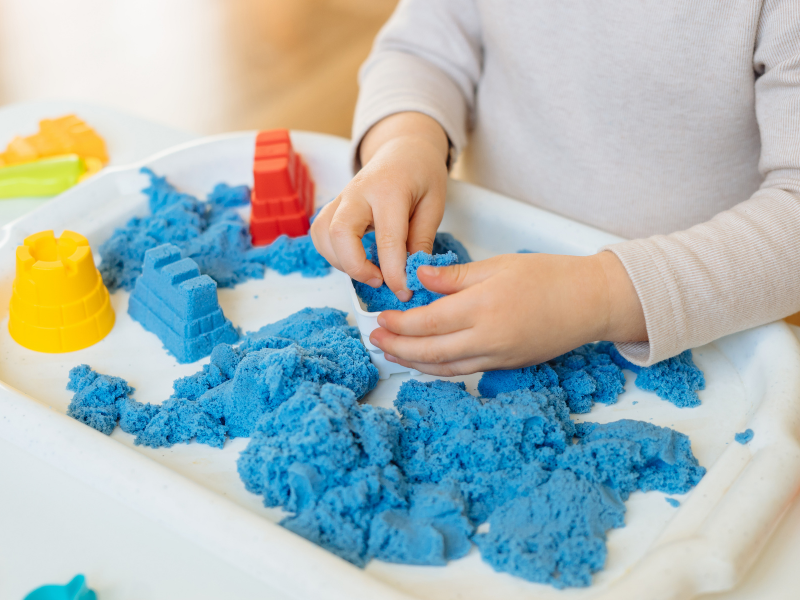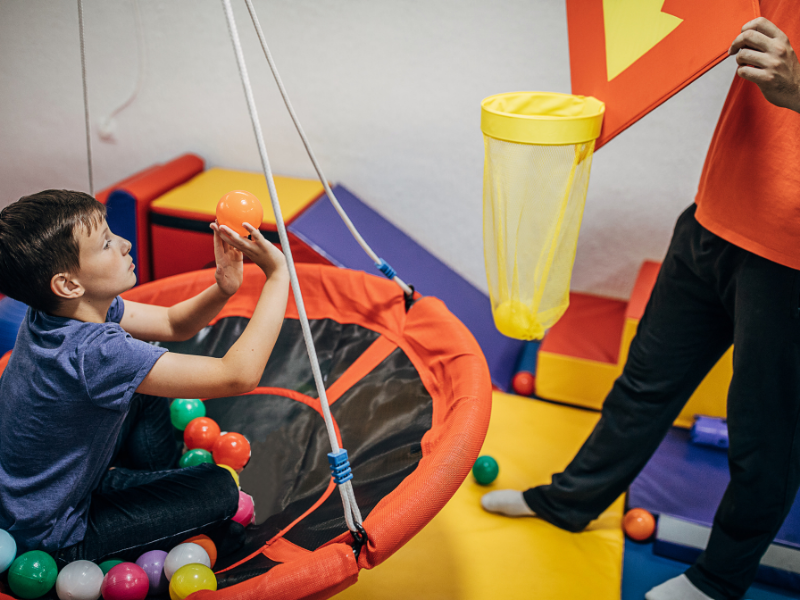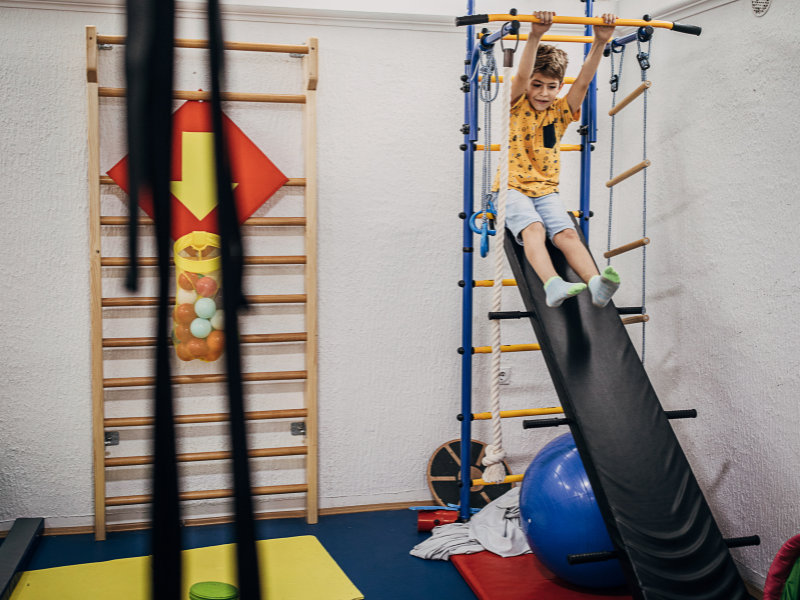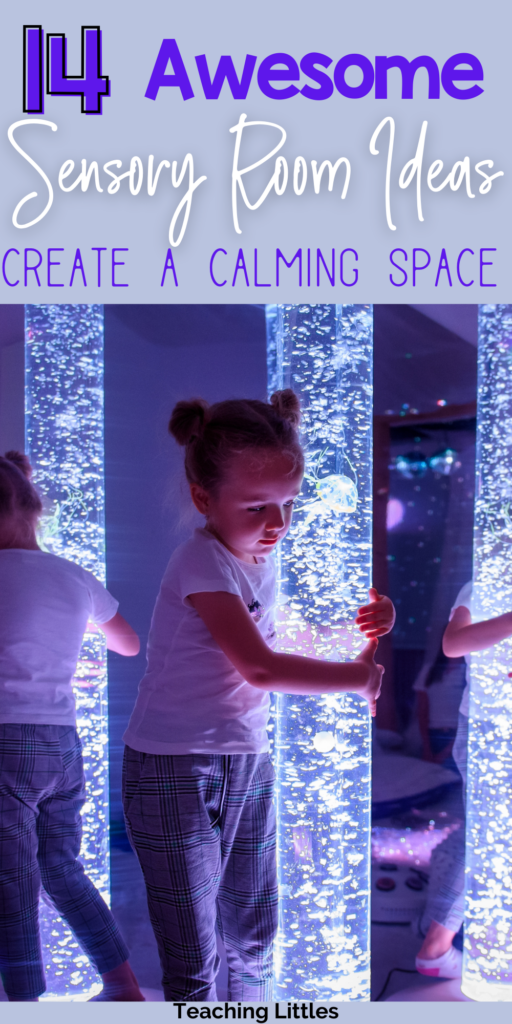All children, whether they have special needs or not, benefit from sensory activities. Adding a sensory room to your home or school is a great way to provide kids with a sensory experience to help regulate their emotions.
When creating this space for your child, make sure you consider your child’s sensory needs. Some children require more visual input, such as optic lights, while others need different experiences.
Sensory seekers want to climb, jump, and use their gross motor skills. They have a lot of energy to burn.
Believe it or not, people of all ages benefit from a sensory space. Most people find different textures, fidget toys, or even loud music a way to self-regulate.
So, let’s take a look at how you can create an awesome sensory room space.
Related: 10 Inexpensive Sensory Shakers and Noise Makers
What is a Sensory Room?

A sensory room is a safe place for child with a range of disorders, such as autism or sensory processing disorder, to go when they need to feel calm or stimulate their senses. Each child will use a sensory room in a way that benefits them the most.
Sensory rooms contain different activities that engage a child’s five senses.
You often see these rooms in elementary schools and special need schools, but many children’s museums and therapy clinics. More parents than ever are including their home, and you can set one up on a budget.
What Are the Benefits of a Sensory Room?
You might think the only benefit of a sensory room is to engage their senses and allow them to play, but it does more than that. Individuals with sensory, cognitive, and physical disabilities feel empowered in these spaces. Each item is selected to solve a problem a child may feel during the day.
Related Post: How to Explain Autism to kids – Serenity Kids
Here are some benefits of a sensory room.
- It gives children a fun environment to be active, which often helps children focus.
- This gives your children a safe space to practice their gross motor skills, building confidence in their abilities.
- You will notice that a sensory room reduces disruptive behaviors caused by sensory seeking or sensory overload, common in autism spectrum disorder.
- Sensory rooms calm and relax your kids, improving their emotional regulation skills.
14 Sensory Room Ideas
1. Pick the Right Flooring
When considering sensory room ideas, make sure the flooring is soft enough for your child. Chances are your kid will fall or crash several times, and the right flooring reduces injures. If you put this space somewhere with concrete floor, like a basement, you want to make sure you have plenty of padding.
There are plenty of options!
- Try putting down thick, high-quality foam tiles that interlock. Don’t go for the thin, flimsy ones because they won’t give any cushion to your child.
- Put extra padding in high risk areas, like underneath climbing equipment.
- Gel floor tiles are great and make the overall experience better. These are an area your child can sit, step on the tiles, or jump, watching the colors ooze and move together.
2. Sensory Swing
One of the best sensory room ideas is to add a sensory swing to this space. Each sensory swing is different; some are a platform and others are fabric.
Adding a swing to your sensory space provides your child with vestibular input, helping your child calm down and learn where their body starts and ends.
No matter which one you pick, make sure it fits well and installs easily into your home. If you are worried that it might not install safely, some sensory swings come with stands!
3. Include Sensory Lighting

You want to include some sort of lighting for your child to enjoy, but sensory lighting is different than your typical lights. These provide visual sensory input rather than simply illuminating the space.
The right sensory lighting improves the overall experience; it creates a calming environment. These lights are mesmerizing and prevents meltdowns. Avoid bright fluorescent lights – often seen in classrooms – because it causes your child to feel overstimulate.
Here are some sensory lighting options.
- Lava Lamps
- Sensory Light Projector
- Fiber Optic Curtain Lights
- Glowing Bubble Tubes Lights
- Galaxy Light Projector
- Tap Tap Led Lights
4. Add Sensory Seating
Make sure to include some special seating for your child; it’s one of the top sensory room ideas. There are several kinds of sensory sating to consider, such as seats that provide compression.
Another option is a bean bag chair; these are big and durable enough that your child can jump into it and climb over it without it acting only as a seat. Who doesn’t love bean bags?
5. Body Socks are a Must
Body socks may look silly, but they provide excellent sensory input that improves your child’s sense of their body.
6. Include Balance Tools
Another great addition to your sensory room is balance tools. Try including a balance beam, or get balance boards if you lack space. Other options include stepping stones since these are portable and space savers.
Kids love Wobble Balance Boards! This tool looks simple but it’s a versatile tool that stimulates the vestibular system. It works great as a seating option, as well as a balance tool for climbing and sliding.
7. Don’t Forgot Tactile Media

Children need tactile sensory input, so include a low table with some storage containers to serve as sensory bins. You can rotate out the items whenever you want, but there are plenty of things to include for tactile experiences.
Here are some things that belong in sensory bins.
- Sand
- Rice
- Beans
- Kinetic Sand
- Pasta
- Shaving Cream
- Play-Doh
Related: Shaving Cream Writing: A Fun Learning Activity
8. Jump & Bounce on Trampolines

Jumping gives child proprioceptive and vestibular input, even for adults. The great thing is you can find trampolines of all shapes and sizes. Some of these are better for young kids while others are good for more than one child.
They even have folding legs on trampolines if you need to save space.
9. Grab Sensory Tools
If you have a small space, include at least three to five sensory tools; you don’t want to fill the space too much. Larger spaces hold more tools, up to 20!
Here are some ideas.
- Sensory Bottles
- Vibrating Massage Bugs
- Fidget Toys
- Scooter Boards
- Peanut Ball
- Crash Pad
- Vibrating Cushion
- Large Pillows
- Ball Pit & Balls
- Gel Pad Tiles
- Rodi Bouncer
Related: How to Make Simple DIY Glitter Sensory Bottles
10. Climbing Walls are Fun

If your child needs to engage their gross motor skills regularly, include a climbing wall in the space. Many of these work even in small spaces, or some families add climbing options to a wall in their stairway.
Another option is to buy a temporary climbing wall or a doorway swing option.
If you have the budget to afford an indoor play gym, your child will love this climbing equipment because it folds flat!
11. Plenty of Balls
Balls make a great addition to any sensory room. Consider adding a yoga ball, exercise ball, or a stability ball; these can be rolled over to increase upper body strength or provide deep pressure input.
Make sure you also have a basket of smaller baskets. Sensory balls can be rolled between their hands or over their skin.
12. Tunnels & Quiet Spaces
A collapsible or fold-up tunnel encourages your child to crawl through the space. Some kids love the visual enclosure; they can crawl on their bellies and be alone with a book or a blanket.
If you don’t want to add a tunnel, create a quiet space for a sensory deprivation area. This can be a simple pop-up tent with pillows and a blanket.
For example, a sensory tent provides your child with a safe hiding spot to reduce dysregulation.
13. Have a Weighted Blanket or Lap Pad
Most sensory rooms have weighted products that provide your child with a feeling of being grounded. These feelings are called deep touch pressure, and it helps calm down your child because of the serotonin release.
Put a weighted blanket or lap pads in a basket in the corner of your room. Whenever your child needs the release, they can grab the blanket and cuddle up.
14. Make Sure to Decorate
Even though this is a sensory room, some decoration will bring the entire space together and add the perfect finishing touches. However, if your child gets overwhelmed with too much visual sensory input, avoid too many colors and patterns.
Here are some ideas.
- Paint a focus wall with a dark color, such as a navy blue or burgundy, because it will accentuate the fiber optic lighting.
- Put up self-adhesive mirror tiles.
- Add glow in the dark wall decals.
Creating a sensory room for your child is a great way to embrace their needs and provide them adequate releases. Many parents notice an overall improvement in their child’s behavior when giving them the tools they need!


